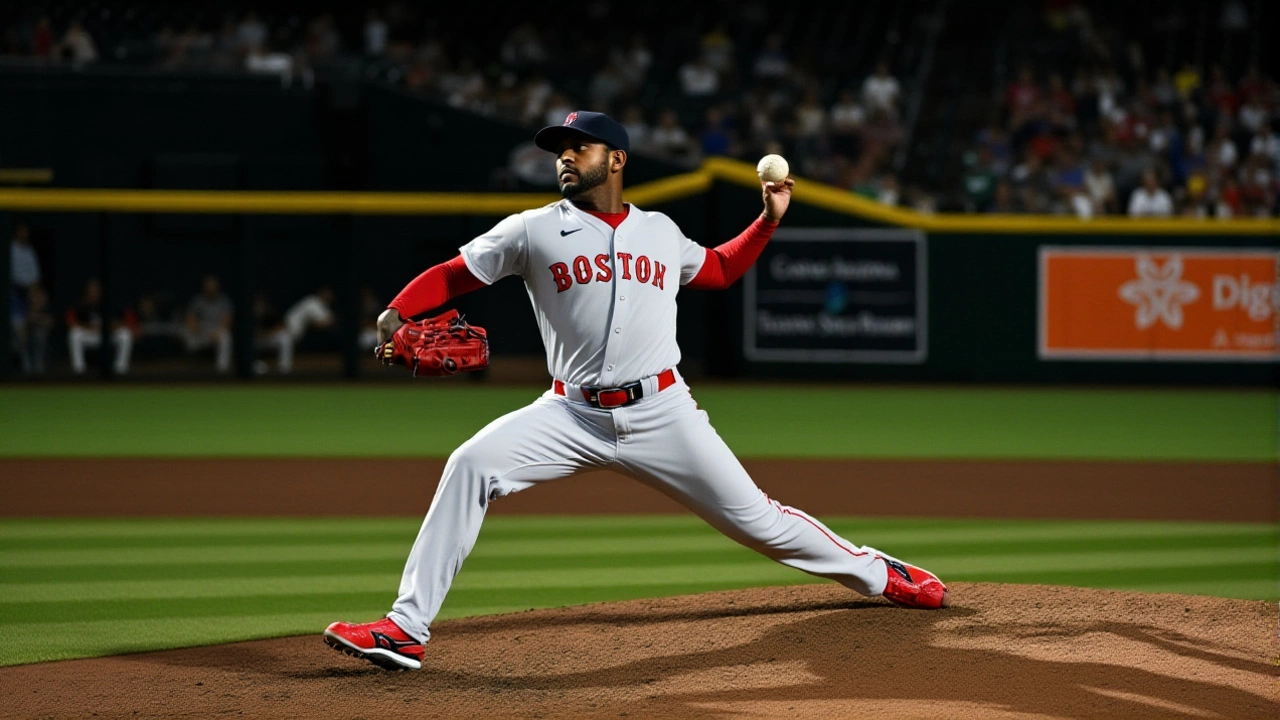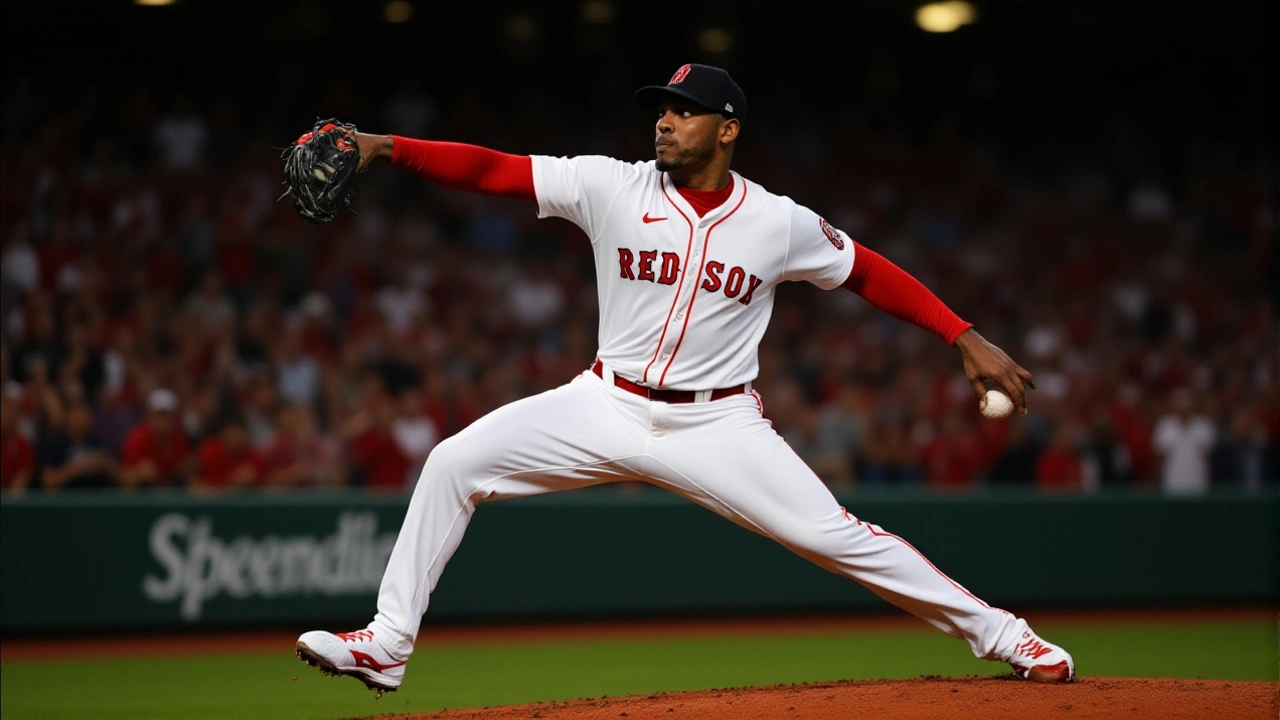When Aroldis Chapman, a left‑handed closer for the Boston Red Sox, signed a one‑year extension on August 31, 2025, the club secured his services through the 2026 season with a mutual option for 2027. The deal, announced at a press conference in Boston, Massachusetts, comes after Chapman posted a franchise‑record 15 straight hitless outings and a microscopic 1.02 ERA. It matters because Boston, still reeling from the June trade of star third‑baseman Rafael Devers, finally found a late‑season spark that could reshape its postseason odds.
Background: Chapman’s Journey to Boston
Before landing in Fenway, Chapman’s résumé spanned seven clubs. He debuted with the Cincinnati Reds in 2010, then spent five seasons in New York with the New York Yankees, where he earned his first All‑Star nod. Stints with the Chicago Cubs, Kansas City Royals, Texas Rangers, and Pittsburgh Pirates followed, each adding to his 362‑save total. The 37‑year‑old’s career had been a roller‑coaster — three straight seasons with an ERA above three before 2025, and a series of shoulder concerns that made teams wary.
Boston signed him in November 2024 on a one‑year, $10.75 million guarantee, hoping his fastball‑‑still ticking near 100 mph‑‑could anchor a bullpen that had lost its identity after the Devers trade. The gamble paid off spectacularly.
2025 Season: Numbers That Shocked the League
Chapman appeared in 58 games, recording 27 saves while logging the lowest ERA among relievers with a minimum of 50 innings pitched. His 1.02 ERA translated to just six earned runs over 53.0 innings, and his WHIP of .66 was the best in MLB. He struck out 77 batters in 54 innings, a strikeout‑per‑9‑innings rate of 12.8, and held opponents to a .117 batting average.
- 15 consecutive hitless appearances (July 26 – August 31)
- 1.00 ERA over the final 35 games
- 0.28 ERA in the last 32 innings pitched
Even more impressive, Chapman’s “vest” stretch—32.0 innings from May 28 onward—saw him surrender just seven hits in 102 at‑bats. Analysts at The Athletic called his performance “the most dominant half‑season by a reliever in the last decade.”
Details of the Extension Deal
During the Red Sox contract extension announcementBoston, the terms were laid out crystal‑clear. Chapman receives a $1 million signing bonus and $12 million guaranteed salary for 2026. The mutual option for 2027 is priced at $13 million, with a $300,000 buyout. To vest, Chapman must throw at least 40 innings in 2026 and pass a post‑season physical; if he does, the $13 million kicks in, capping a two‑year haul at $26 million.
His representation, Wasserman, negotiated the vesting clause after noting his 2025 durability—he logged 54 innings despite a heavy workload.
Reactions from the Club and the Player
“Aroldis has given us a reason to believe we can compete for a pennant,” said Alex Cora, manager of the Red Sox. “His work ethic, his story, it resonates with the entire organization.”
Chapman, ever the stoic, replied, “I love Boston. The fans embraced me, and I want to keep delivering. The numbers speak for themselves—if I can stay healthy, I’m happy to be here.”
Baseball analyst Jesse Rogers of MLB Network noted, “The financial jump isn’t just about money; it’s a vote of confidence. A $3.5 million raise after a $10.75 million season signals Boston believes Chapman can be a cornerstone of a playoff run.”
Implications for Red Sox Strategy
Locking Chapman in through 2026 gives Boston flexibility elsewhere. With a reliable closer, the front office can divert resources toward a middle‑of‑order bat that replaces the void left by Devers. Moreover, the vesting clause aligns Chapman’s incentives with the club’s: more innings means more chances to win late games, which in turn improves Boston’s win‑probability matrix.
Should Chapman meet the 40‑inning threshold, the club can consider extending the partnership further, perhaps negotiating a multi‑year deal that mirrors the $200 million contracts handed to elite starters in recent seasons. Even without the option vesting, the $12 million salary sets a new benchmark for relievers in the American League East, nudging competitors like the Yankees and the Blue Jays to reassess their own bullpen allocations.
In the bigger picture, Chapman’s resurgence underscores a trend in MLB: veteran relievers finding second wind with refined mechanics and smarter usage. If Boston’s gamble pays off, other small‑market teams may follow suit, targeting high‑velocity swingmen on short‑term, performance‑based contracts.
What’s Next for Boston and Chapman?
The next step is simple: stay healthy. Chapman’s immediate goal is to log the required 40 innings before the season ends on October 2, 2026. The Red Sox will likely monitor his pitch count closely, especially during the September roster expansion when the playoff picture sharpens.
Meanwhile, Boston’s front office, led by President of Baseball Operations Chaim Bloom, hinted at a potential mid‑season trade to add depth at first base, a position left thin after Devers’ departure. If Chapman’s dominance continues, Boston could be one of the first American League East clubs to clinch a wild‑card berth.

Frequently Asked Questions
How does the extension affect the Red Sox’s payroll flexibility?
By committing $12 million (plus a possible $13 million option) to Chapman, Boston frees up mid‑level salary space that can be used to shore up the lineup, especially at first base. The vesting clause ties additional money to performance, so the club only pays extra if Chapman stays productive.
What milestones must Chapman hit to trigger the 2027 option?
He needs to pitch a minimum of 40 innings during the 2026 regular season and pass a post‑season physical examination. Meeting both criteria locks in the $13 million salary for 2027.
Will Chapman’s performance impact trade rumors surrounding the Red Sox?
Absolutely. A reliable closer makes Boston a more attractive playoff contender, which can shift the market value of other Red Sox assets. Teams looking to buy a contender may be willing to part with higher‑priced prospects to fill gaps left by the Devers trade.
How does Chapman’s 2025 season compare historically to other relievers?
His 1.02 ERA, .66 WHIP, and 15 straight hitless outings rank among the best half‑season stretches ever recorded. Only a handful of relievers, such as Mariano Rivera in 1999, have posted comparable numbers over a similar workload.
What does the contract mean for other teams in the AL East?
It signals that the Red Sox are willing to pay premium rates for elite bullpen arms. Rival clubs may feel pressure to match or exceed that spending to stay competitive in close series, potentially inflating the market for high‑velocity closers.

